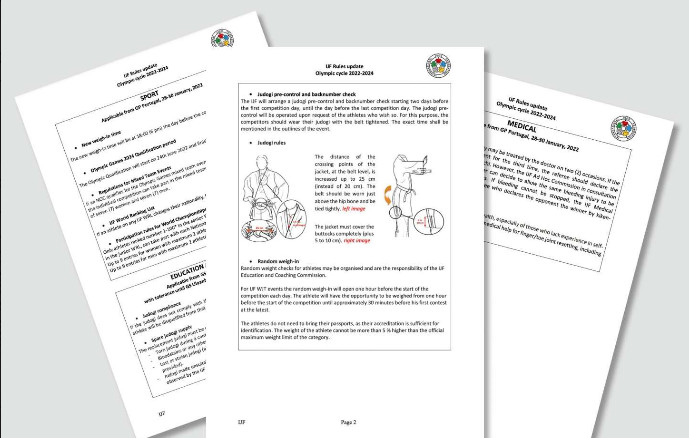Find below the most updated information about the judo rules (Sport, Education and Medical) for the Olympic cycle 2022-2024.
Decision 1:
Scoring for actions that, without stopping, are a continuation of techniques.
If there is a stop in the action, there is no score.
Decision 2:
Waza–ari criteria comprises landing on the whole side of the body at 90 degrees or more to the rear, or on one shoulder and upper back. A score will be given for a whole side of the body landing even when the elbow is out. Hip and shoulder position must be considered.
Decision 3:
Waza–ari criteria comprises landing on the whole side of the body at 90 degrees or more to the rear, or on one shoulder and upper back. A score will be given for a whole side body landing even when the elbow is out.
Decision 4:
Landing simultaneously on 2 elbows or hands, towards the back, is waza–ari for tori and shido for uke.
Decision 5:
No score for counter techniques where the initial attack is rolled to the back, towards the counterattacking or defending judoka.
Decision 6:
No score and shido for reverse seoi–nage.
Decision 7:
Gripping under the belt in the end phase of a throwing technique is allowed if the
opponent is already in ne–waza. If the throwing technique is interrupted, gripping under the belt is a ne–waza action.
Scoring for actions that, without stopping, are a continuation of techniques.
If there is a stop in the action, there is no score.
Decision 2:
Waza–ari criteria comprises landing on the whole side of the body at 90 degrees or more to the rear, or on one shoulder and upper back. A score will be given for a whole side of the body landing even when the elbow is out. Hip and shoulder position must be considered.
Decision 3:
Waza–ari criteria comprises landing on the whole side of the body at 90 degrees or more to the rear, or on one shoulder and upper back. A score will be given for a whole side body landing even when the elbow is out.
Decision 4:
Landing simultaneously on 2 elbows or hands, towards the back, is waza–ari for tori and shido for uke.
Decision 5:
No score for counter techniques where the initial attack is rolled to the back, towards the counterattacking or defending judoka.
Decision 6:
No score and shido for reverse seoi–nage.
Decision 7:
Gripping under the belt in the end phase of a throwing technique is allowed if the
opponent is already in ne–waza. If the throwing technique is interrupted, gripping under the belt is a ne–waza action.
Decision 8:
Collar and lapel grips are allowed if not negative.
Decision 9:
Belt grip, one side grip, cross grip, pistol grip and pocket grip are not traditional grips. If taken, time will be allowed for the preparation of an attack.
Decision 10:
Breaking the grips with one or two hands and immediately taking grips is allowed.
Breaking grips with one or two hands and not taking a grip immediately is shido.
Decision 11:
Retying and arranging judogi and hair is allowed once per judoka per contest. Further occasions are penalised with shido.
Decision 12:
Techniques using head diving are dangerous and will be penalised with hansoku–make.
Collar and lapel grips are allowed if not negative.
Decision 9:
Belt grip, one side grip, cross grip, pistol grip and pocket grip are not traditional grips. If taken, time will be allowed for the preparation of an attack.
Decision 10:
Breaking the grips with one or two hands and immediately taking grips is allowed.
Breaking grips with one or two hands and not taking a grip immediately is shido.
Decision 11:
Retying and arranging judogi and hair is allowed once per judoka per contest. Further occasions are penalised with shido.
Decision 12:
Techniques using head diving are dangerous and will be penalised with hansoku–make.
IJF Rules update 2022-2024 – Sport, Education and Coaching, Medical – ENG Download
Source: www.ijf.org



